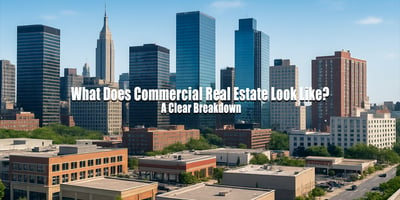Picture this: You walk into a stunning industrial loft with 20-foot ceilings, exposed brick walls,...
Which Commercial Real Estate Is the Most Profitable?
Let’s cut to the chase: you want to know what type of commercial real estate (CRE) prints money fastest in the U.S. You’re not some dreamer who wants a lukewarm ROI, you're after profits that look like they’ve been on steroids. So here’s the brutally honest playbook.

1. Multifamily Apartment Buildings - The Reliable Workhorse
Why it rocks: People always need a roof. Multifamily properties (think 4+ units, up to high-rises) deliver recurring income with occupancy risk mitigated by high demand. You collect rent month after month, and inflation often allows you to raise rents.
- Nationwide ROI: Healthy, usually 6–10% cap rates pre-leverage in major metros.
- Example (Phoenix, AZ): Sun Belt city, soaring job growth, and inbound migration. Multifamily owners here are seeing crazy low vacancy rates, often under 5% allowing them to hike rents 3–5% annually. That’s real compounding.
- Contrast (Rust Belt: Cleveland, OH): Cap-rates can stretch into the 7–9% range, offering higher yield but you have to wrestle with slower rent growth and tougher tenant pools.
Alex-style hook: You know what beats a one-time sale? A steady paycheck. Multifamily is your dividend-paying, boring grandparent that suddenly turns sexy when the market’s hot.
2. Industrial / Logistics: The Quiet Winner
With the e-commerce tidal wave still crashing, industrial real estate warehouses, distribution centers, last-mile logistics is quietly crushing it.
- National trends: Big players like Amazon, Walmart, and regional carriers are gobbling up space. Cap rates nationally have compressed to around 5–7%, and investors are OK with that in exchange for long-term tenants and rent escalations.
- Example (Savannah, GA vs. Inland Empire, CA):
- Savannah: Port expansion means massive wholesale and logistics demand. You’re playing with great yield, moderate competition.
- Inland Empire: Closer to L.A., super hot, but pricing is aggressive, cap rates nearer 4–5%. You pay for proximity but get ultra-stable tenancy.
- Savannah: Port expansion means massive wholesale and logistics demand. You’re playing with great yield, moderate competition.
Why this matters: Industrial isn’t flashy, it doesn’t have rooftop lounges or marble lobbies but it prints. If your taste is for low-vacancy, long leases, minimal management headaches (no bedrooms, no tenants late on rent), this is your domain.
3. Office Space: The Risky Rebel
Office used to be king. Post-pandemic, it's shaky. Demand has cratered, vacancies are up, and work-from-home inertia is real.
- Big cities (New York, SF, Boston): Vacancies soared. Cap rates widened, sometimes heading into the 8–10% or higher range. That’s juicy yield but only if you're willing to hang on and reposition.
- Secondary/Mid-size markets (Austin, TX; Nashville, TN): Better story. Tech and creative sectors fueling growth mean certain A+ buildings are holding up. Smart investors who reposition office into mixed-use (think coworking, residential conversion, or amenity-heavy space) can capture outsized returns.
Alex-style truth bomb: Office isn’t dead, it's on life support. If you can add value, you might resurrect it. Otherwise? Step carefully.
4. Retail: The Reinvented Mix
Think “strip mall” and you think of Sears in 2020. But retail isn’t monolithic:
- Necessity-Based (grocery-anchored, service-focused): These are still gold, people buy food, salons stay busy. That yields stable returns (5–7% cap rates). Example: Sacramento, CA sees suburban shopping centers anchored by grocery chains still nearly fully leased.
- Experiential/Trophy Retail (urban flagship stores, mixed use, lifestyle centers): These are riskier but can deliver high growth, if you're in a place like Miami’s Wynwood or Austin’s downtown. Cap rates might be tighter, but rental growth and foot traffic can snowball.
Key takeaway: Retail isn’t one-size-fits-all. Anchor tenants and location matter. Nail those, and you’re in business.
5. Niche Winners: Self-Storage & Medical Office
Don’t sleep on these:
- Self-Storage: Low maintenance, high margins, recession-resistant. Smaller-scale investors LOVE these. Cap rates around 6–8%, depending on submarket.
- Medical Office: Healthcare never quits. Chapel Hill, NC-hospitals expanding and strapped suburban markets see medical flex conversions earning premium rents and reliable tenants.
State-by-State - Quickfire Breakdown
Let’s illustrate key variations across states:
|
State |
Top-performing CRE Type |
Why It Hits |
|
Texas (Austin, Dallas) |
Multifamily + Industrial |
Population boom, job growth, corporate relocation |
|
Florida (Miami, Orlando) |
Multifamily + Retail (tourism-driven) |
Tourist economy, migration, steady essentials |
|
Georgia (Atlanta, Savannah) |
Industrial + Multifamily |
Logistics hub, port access, urban growth |
|
California (LA, SF) |
Selective Multifamily, high-end mixed-use |
Regulation-heavy, high cost - but ultra-high rent levels |
|
Ohio (Cleveland, Columbus) |
Multifamily |
Value-oriented, slower growth but better yields |
|
Massachusetts (Boston) |
Office (specialized) + Medical Office |
Universities, hospitals, biotech stabilizing returns |
Final Surge: What’s Most Profitable?
Here’s where you lean in: multifamily and industrial are punching way above their weight as the most consistently profitable CRE asset types nationwide. They dominate because:
- Multifamily - you collect rent every month. Inflation gives you optionality to bump rents. Even in slower markets, occupancy is resilient.
- Industrial - lean, clean, repeat. Long leases often with built-in escalation clauses and minimal operational headaches.
If I had to pick a single “most profitable,” across the spectrum, it’s industrial in Sun Belt logistics hubs (think Dallas, Phoenix, Atlanta, Savannah). Why? You get compression, demand tailwinds, and tenant profiles that treat you like landlord, not adversary.
But and this is Hormozi-level honesty:

- Capital stack matters. Don’t just eyeball cap rates. Underwrite using realistic rent growth, vacancy assumptions, interest rates.
- Execution beats strategy. Even the hottest asset class fails if you overpay or can’t manage effectively.
- Local nuance is critical. Phoenix multifamily delivers better growth than Cleveland’s. Inland Empire warehouses trade differently from those in rural Ohio.
Real-Life Micro Example:
- Investor A buys a 100-unit multifamily in Phoenix in 2022. Let’s say they paid a 6% cap on $10M. They’ve raised rents 4% annually, kept vacancy near 3%, and refinanced in 2024 at a lower cap value-add in action.
- Investor B snaps up a 200,000 sq ft industrial facility near Savannah. Ten-year lease with rent escalations. Cap rates were 5.5% lower yield, yes but ultra-lease stability and growth as logistics demand balloons.
These are not hypothetical unicorns; they replicate across thousands of deals.
Final Word — Action Steps for Hutfin.com readers:
- Zero in on industrial and multifamily in high-growth states.
- Model the worst-case scenario, then bet on your management edge.
- Call your local broker in Dallas, Phoenix, Atlanta, or Tennessee - you’ll see real AE’s who will show you deals that fit.
- Use a platform like hutfin.com to compare offers, understand cap rate trends, and watch competition transparency wins.
Profit is not a fairy tale. It’s demand, location, lease structure, and execution fused into cash flow. Whether you're scaling 4-plex portfolios in Houston or buying warehouses in Savannah, if you follow those rules, you’ll print returns that feel unfair.
Keep building, keep executing, and let the assets pay your future.




